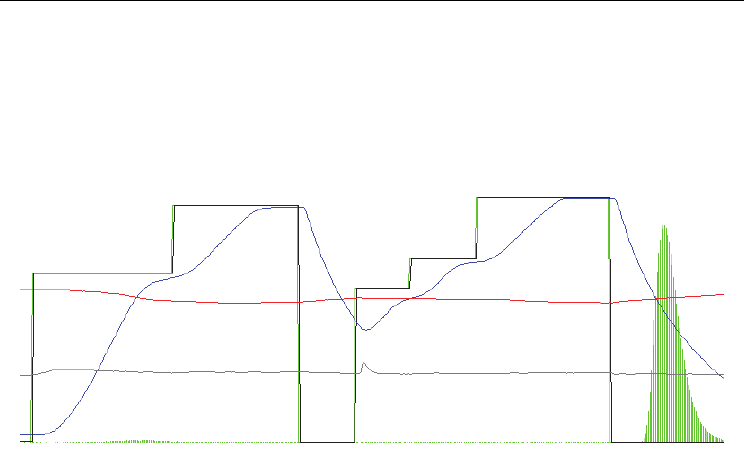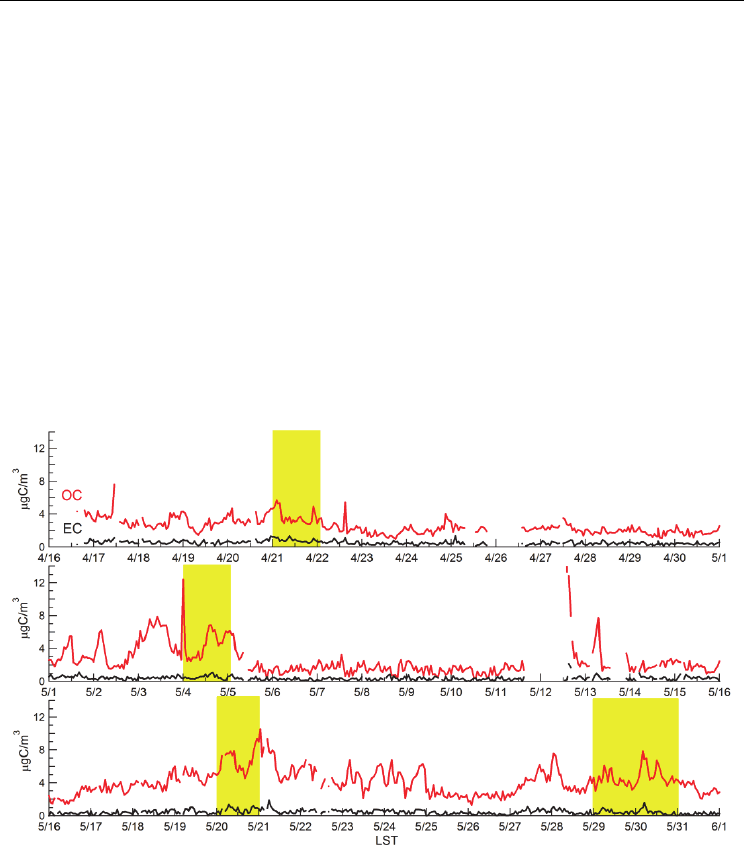Kumar E.S. (ed.) Integrated Waste Management. V.I
Подождите немного. Документ загружается.

27
Measurements of Carbonaceous
Aerosols Using Semi-Continuous
Thermal-Optical Method
Yu, Xiao-Ying
Pacific Northwest National Laboratory
USA
1. Introduction
Waste management involves collection, transport, processing, recycling, disposal, and
monitoring of waste materials that can be solid, liquid, gaseous, or radioactive, which all are
generated by human. It is important to monitor aerosols emitted during waste treatment
and management to understand their impact on human health and the environment.
Carbonaceous aerosols are major components in air pollution as a result of energy
consumption, thus measurement of them is important to waste management. Increasing
interest has been drawn to the identification, measurement, analysis, and modeling of
carbon aerosols in the past decade. This book chapter will provide a review of the widely
used semi-continuous thermal-optical method to determine carbonaceous aerosols in
relation to air pollution and waste management.
Quantification of carbonaceous species provides important observations in understanding
aerosol life cycle. Carbonaceous aerosols play important roles in air quality, human health,
and global climate change. However, accurate measurement of carbonaceous particles still
presents challenges. Carbonaceous particles are divided into three categories: organic
carbon (OC), elemental carbon (EC), and inorganic carbonate carbon (CC) [Chow et al., 2005;
Schauer et al., 2003]. The terms “elemental carbon (EC)“, “soot”, “black carbon”, “graphic
carbon”, and “light absorbing carbon” are often used loosely and interchangeably in
different research areas. Atmospheric EC particles are produced almost exclusively under
incomplete combustion conditions. They are from both anthropogenic and biogenic
emissions. Ambient elemental carbon particles rarely appear as diamond crystalline
structure. EC aerosols absorb light effectively and they can be characterized by light
scattering, absorption, or transmittance, as well as other methods. Absorption spectroscopy
is deemed to provide quantitative information of EC. Difference in the definition of EC is a
result of measurement methods [Jeong et al., 2004; Watson et al., 2008].
Increasingly OC has drawn more attention because of its effect on regional air pollution and
global climate change. OC aerosol formation is attributed to both biogenic and
anthropogenic sources [Bond & Bergstrom, 2006]. OC may be released directly into the
atmosphere (primary organic aerosol) or formed when gaseous volatile organic compounds
are released to the atmosphere followed by photolysis induced oxidation to form secondary
organic aerosols [Bae et al., 2004; Schauer et al., 2003]. Past findings indicate that a large

Integrated Waste Management – Volume I
522
percentage of OC observed around the world is secondary [Zhang et al., 2007]. This chapter,
however, focuses on the widely used semi-continuous thermal analysis method.
Comparisons among relevant methods are also provided.
2. Thermal desorption analysis methods
Thermal desorption has been used to analyze volatile organic compounds. The physical
principle lies in the fact that different components of a sample volatize, oxidize, or react
with other reagents as the temperature profile changes [MacKenzle, 1970]. Many methods
employ a two-step temperature profile. Generally speaking, sample is heated in the first step
to a temperature ranging from 350 C to 850 C. Carbon evolved in this step is defined as
OC. In the second step, sample is heated to a temperature ranging from 650 C to 1100 C.
Carbon evolved in this step is defined as EC. At the first temperature regime, the
volatilization rate of EC is assumed to be low, and OC evolution occurs in an atmosphere
without an oxidizing agent. Carbon dioxide (CO
2
) gas forms as a result of OC evolving from
the sample. In step 2, an oxidizer is introduced. Oxygen (O
2
) is often used. EC reacts with
this oxidizing agent, sometimes under catalysis conditions, to form CO
2
. CO
2
is detected
directly. A methane (CH
4
) – helium (He) mixture is used to calibrate the system; the CH
4
is
oxidized in the same manner to achieve quantification. The original compounds are
transformed due to thermally-induced reactions (dissociation or oxidation). The detection is
not chemically specific using the thermal analysis method. Results are often reported as
empirically and operationally defined categories including OC, EC, and TC. TC is the sum
of OC and EC (TC=OC+EC).
An important factor in thermal evolution methods is the OC/EC split point. Many methods
use Optical Reflectance and/or Optical Transmission to monitor the conversion of OC to EC
and the oxidation of EC to CO
2
. The rationale is that since EC is not volatile until very high
temperatures (well above the ~840 C used by the NIOSH method, for example), its release
is only dependent on oxidation when oxygen is present. High temperatures in the non-
oxidizing environment often cause some OC components to form EC by charring. This
complicates the determination of EC as additional EC is formed due to this charring. When
oxygen is added to the sample oven, the black EC char will combust and the filter becomes
white. When the light intensity from reflection or transmission of the samples on the filter
reaches its original intensity, the charred OC is assumed to be removed. The OC/EC split
point is usually defined in this manner. It is assumed what comes off after the split point is
quantitatively nearly equal to the EC that was on the filter originally as EC.
Thermal-Optical methods assume that: (1) The EC caused by charring of OC’s during the
first O
2
-free step is more easily oxidized; or (2) that the absorption coefficient of the EC
formed by charring is similar to the absorption coefficient of the original EC within the filter.
If either of these assumptions is correct, then the method will be an effective quantitative
method of OC and EC. Although the operational principle is similar, subtle differences exist
among the different methods. These factors may include analysis atmosphere, temperature
profiles, optical monitoring approaches, sample size, and other differences in physical
configurations of the analytical instrument [Watson et al., 2005; Chow et al., 2005]. Some
examples of more detailed studies of the effect of using TOT and TOR on the OCEC split
point are discussed elsewhere [Chow et al., 2004; Cheng et al., 2009].
Particulate samples are usually collected using filters ranging from several hrs to days, then
samples are prepared for off-line analysis in the laboratory. For OC and EC laboratory

Measurements of Carbonaceous Aerosols Using Semi-Continuous Thermal-Optical Method
523
analysis, the Sunset instrument (Sunset Laboratories Inc.) and the DRI (Desert Research
Institute) instrument are among the most commonly used. Near real-time or real-time on-
line techniques are advantageous compared with off-line ones, because they provide faster
sampling resolution and reduce labor in analysis. More importantly, the faster time
resolution makes it possible to capture fast changing fluctuations of particle emisisons,
where the off-line methods would have missed due to the longer sampling time.
Fig. 1. An example of the modified NIOSH thermo-optical analysis thermal desorption
diagram of a field sample. The x-axis is time in seconds, and y-axis is intensity of different
traces. The blue color is oven temperature; red NDIR laser intensity; gray pressure; and
green carbon dioxide.
Several techniques are established for in situ determination of black carbon (BC), such as the
aethalometer and the particle soot absorption photometer. The relationship between BC and
EC, however, is not fully resolved. These on-line EC methods do not provide OC
measurements simultaneously. The Sunset Semi-Continuous Organic Carbon/Elemental
Carbon (OCEC) Aerosol Analyzer has been a successful development for on-line OC and EC
measurement. It can provide measurements of OC and EC on hourly time scales,
and it
allows for semi-continuous sampling with analysis immediately after sample collection. The
instrument provides quantification of both OC and EC aerosols and requires no off-line
sample treatment and laboratory analysis. This reduction in complexity, along with the
ability to measure OC and EC on an hourly basis, provides advantages over conventional
off-line integrated techniques.
Aerosol light absorption can be used to determine EC (or BC) either on filter media or in
situ. There are several commerically avaialble instruments based on aerosol light absorption
including the aethalometer, particle soot absorption photometer (PSAP), micro soot sensor,
multi-angle absorption photometer (MAAP), photo-acoustic soot spectrometer (PASS), and
single particle soot photometer (SP2). Moosmüller et al. [2009] provides a detailed review of
these techniques. Due to the commericial avaiability of these fast in situ instruments, more
comparisons have been made to the EC measurements among them. Instrument uncertainty
and minimum detection limits were determined for these techniques. Some recent examples
of these quantities and comparisons are seen in Chow et al. [2009], Cross et al. [2010],
Slowick et al. [2007].
Other newer developments often involve mass spectrometery. One such successful example
is the aerosol mass spectrometer [Jayne et al., 2000]. However, it does not provide

Integrated Waste Management – Volume I
524
simultaneous EC measurements, although it can provide faster resolution of total organic
aerosol. The latter is often deduced to primary and secondary components using positive
matrix factorization (PMF) analysis. As a result, it is more labor intensive to operate and
conduct data reduction. In addition, MS based instruments are often more expensive to
purchase. They take more power and space, therefore, not immediately accessible for long-
term regulatory monitoring purpose in waste management.
2.1 The Sunset OCEC analyzer
The semi-continuous Sunset OCEC analyzers (Model 3F, Sunset Laboratory Inc., Portland,
OR) is widely used to measure OC and EC mass loadings at different locations. Ambient
samples were collected continuously by drawing a sample flow of ~8 lpm. A cyclone was
used upstream of the instruments to pass particles smaller than 2.5 µm. The airstream also
passed through a denuder to remove any volatile organic compounds in the air. Sample
flow rate was adjusted for the pressure difference between sea level and each of the sites to
ensure accurate conversion of sample volume. During automated semi-continuous
sampling, particulate matter was deposited on a quartz filter. The quartz filter was normally
installed with a second backup filter, mostly to serve as support for the front filter. The
portion of the sample tube containing the quartz filter was positioned within the central part
of an oven, whose temperature was controlled by an instrument control and data logging
program installed on a laptop computer and interfaced with the OCEC instrument.
After a sample was collected, in situ analysis was conducted by using the modified NIOSH
method 5040, i.e., thermal optical transmittance analysis, to quantify OC and EC. The oven
was first purged with helium after a sample was collected. The temperature inside the oven
was ramped up in a step fashion to ~ 870 °C to thermally desorb the organic compounds.
The pyrolysis products were converted to carbon dioxide (CO
2
) by a redox reaction with
manganese dioxide. The CO
2
was quantified using a self-contained non-dispersive infrared
(NDIR) laser detection system. In order to quantify EC using the thermal method, a second
temperature ramp was applied while purging the oven with a mixture containing oxygen
and helium. During this stage, the elemental carbon was oxidized and the resulting CO
2
was
detected by the NDIR detection system. At the end of each analysis, a fixed volume of
external standard containing methane (CH
4
) was injected and thus a known carbon mass
could be derived. The external calibration was used in each analysis to insure repeatable
quantification. The modified NIOSH thermal-optical transmittance protocol used during a
field study in Mexico City is summarized in Table 1.
Errors induced by pyrolysis of OC are corrected by continuously monitoring the absorbance
of a tunable diode laser beam (λ = 660 nm) passing through the sample filter. When the laser
absorbance reaches the background level before the initial temperature ramping, the split
point between OC and EC can be determined. OC and EC determined in this manner are
defined as Thermal OC and Thermal EC. Total carbon (TC) is the sum of Thermal OC and
Thermal EC, TC = Thermal OC + Thermal EC, or TC=OC+EC. The Sunset OCEC analyzer
also provides an optical measurement of EC by laser transmission, i.e. Optical EC. Optical
OC can be derived by subtracting Optical EC from total carbon, Optical OC = TC - Optical
EC, where TC is determined in the thermal analysis.
Modifications can be made to the temperature steps in the thermal-optical method. Conny et
al. [2003] conducted a study to optimize the thermal-optical method for measuring
atmospheric black carbon employing surface response modeling of EC/TC, maximum laser
attenuation in He, and laser attenuation at the end of the He phase. They tried to minimize

Measurements of Carbonaceous Aerosols Using Semi-Continuous Thermal-Optical Method
525
the positive bias from the detection of residual OC on the filter as native EC by maximizing
the production OC char by the Sunset (TOT) instrument. In addition, they sought to
minimize the negative bias from the loss of native EC at high temperatures. This first study
concluded that for particle samples around 30 to 50 µg, the optimal condition for steps 1- 4
in the He environment are 190 ºC for 60 s, 365 ºC for 60 s, 610 C for 60 s, and 835 C for 72 s,
respectively.
Carrier Gas Duration (sec) Temperature (ºC)
He-1 10 Ambient
He-2 80 600
He-3 90 870
He-4 25 No Heat
O
2
-1 30 600
O
2
-2 30 700
O
2
-3 35 760
O
2
-4 105 870
CalGas 110 No Heat
Table 1. An example of the modified NIOSH 5040 thermal-optical protocol used during the
MILAGRO campaign [Yu et al., 2009].
Recently, Conny et al. [2009] reported an update using the same empirical factorial-based
response-surface modeling approach to optimize the thermal-optical transmission analysis
of atmospheric black carbon. They showed that the temperature protocol in the TOT
analysis of a Sunset Instrument can be modified to distinguish pyrolyzed OC from BC based
on the Beer-Lambert Law. The optimal TOT step-4 condition in the helium environment was
established to be around 830 - 850 C using urban samples via response surface modeling in
their newer findings, although temperature as low as 750 C or as high as 890 C is not
excluded. This optimization is based on two criteria. First, sufficient pyrolysis of OC must
occur in the high temperature helium environment (i.e., He step 4 or the high temperature
step in He), so that insufficiently pyrolyzed OC is not measured as native BC after the split
point. Second, the apparent specific absorption cross sections of OC char and the apparent
specific absorption cross sections of native BC determined by the instrument are assumed to
be equivalent to determine the optimal operation conditions.
2.2 Aerosol sampling inlet and field deployment
In order to eliminate interference from near ground activities, an aerosol sampling stack can
be used adjacent to the dwelling hosting the instrument at a surface site. An example is
given below based on our field deployment experience. The sampling stack is made of PVC
pipe ~ 20 cm in diameter and extending ~ 8 m above ground. The stack inlet is protected by
a rain cap. A heated stainless steel sampling intake tube (~ 5 cm in diameter) is coaxially
positioned in the center of stack ~ 4 m below the top of the stack and extending through the
lower end cap. The airflow through the aerosol sampling stack is ~ 1000 lpm, of which
approximately 120 lpm is drawn into the heated tube. The tube is wrapped with heating
tape and insulation and further encased in a PVC pipe. Electric power is applied to heat the

Integrated Waste Management – Volume I
526
sample line such that the relative humidity (RH) of the sample air is maintained at or below
40%. Much simpler design can be used to obtain equally good sampling results.
Filters are recommended to be changed every few days before the laser correction factor
reached below ~ 90%. Sampling interval shall be determined based upon local mass
loadings. At locations with low mass loadings that are close to the instrument detection
limits, it makes sense to sample for longer time. Otherwise, for semi-real time sampling, the
sample time is usually chosen to be one hour, i.e., 45-minute ambient sampling followed by
15 minutes thermal-optical analysis. Daily, at midnight, a 0-min sampling blank is taken.
Instruments should be calibrated using an external filter with known OC and EC mass
concentrations. Values reported are corrected to ambient temperature and pressure, this is
especially important if the sampling location is elevated. Externally produced standard
filters are recommended to check the precision of instrument as additional quality
assurance. The relative standard deviations deduced from collocated in situ measurements
between the two analyzers are determined to be 5.3%, 5.6%, 9.6%, and 4.9% for Thermal OC,
Optical OC, Optical EC, and TC, respectively [Bauer et al., 2009]. The limits of detection for
OC and EC determined using the thermal-optical method by the Sunset instrument were
estimated to be approximately 0.2 µgC/m
3
[Schauer et al., 2003]. Readers are referred to
previous reviews to find more details about differences among major instruments for
determination of particulate carbonaceous compositions [Chow et al., 2007].
2.3 Thermal carbon and optical carbon
Optical vs.
Thermal
Slope R
2
Locations Reference
OC 0.93±0.01 0.95 Mexico City T1 [Yu et al., 2009]
0.84±0.02 0.37 Mexico City T2 [Yu et al., 2009]
EC 0.89±0.02 0.95 Rochester, NY [Jeong et al., 2004]
0.99±0.07 0.73 Philadelphia, PA [Jeong et al., 2004]
0.58±0.05 -
*
New York City [Venkatachari et al.,
2006]
1.03
**
0.94 Mt. Tai, China [Kanaya et al., 2006]
0.91 0.84 3 sites in New York & 1
site in Turkey
[Ahmed et al., 2009]
1.43±0.01 0.96 Mexico City T1 [Yu et al., 2009]
1.39±0.01 0.91 Mexico City T2 [Yu et al., 2009]
* Not available from the original reference
** Derived from the slope of the linear least-squares analysis of thermal EC vs. optical EC
Table 2. Linear least-squares fit parameters between quantities determined using optical and
thermal-optical approaches
The thermally determined quantities are considered reliable and are used for data reporting.
Some recent studies have looked into the correlation between the thermal-optically
determined quantities thermal OC and thermal EC, and shown that these quantities may be
strongly correlated (Table 2). Strong linear relationships have been seen at multiple locations
with reasonable R
2
. However, the values of the fitting slope vary from ~ 0.6 to ~ 1.4. This
indicates that no single simple numerical relationship can be applied everywhere. One also
needs to take into consideration that some of these studies were conducted at locations of

Measurements of Carbonaceous Aerosols Using Semi-Continuous Thermal-Optical Method
527
low EC mass loadings, which contributes to higher uncertainty in the analysis results. In the
future, similar studies should be done at locations of higher carbonaceous mass loadings,
which would make such comparisons more conclusive. More studies have compared the EC
quantities determined by different in situ techniques. It is still an on-going effort to
determine the differences among these methods [Chow et al., 2009; Cross et al., 2010;
Slowick et al., 2007].
2.4 Carbon monitoring at different locations
Carbonaceous aerosols have been monitored by established networks in the U.S. such as the
Interagency Monitoring of Protected Visual Environments (IMPROVE) and the Speciated
Trends Network (STN). Many intensive field studies have been conducted to study
carbonaceous aerosols in U.S. in addition to the monitoring by the long-term network. No
strong correlations have been seen among OC and other major particulate matter
components such as sulfate, nitrate, or ammonium ions based on a recent study compiling
available ground-based carbon data worldwide [Bahadur et al., 2009]. As more attention has
been directed to the importance of carbonaceous aerosols, more field data would become
available.
Fig. 2. Time series of organic carbon (OC) and elemental carbon (EC) measured at an urban
site in Houston, TX in 2009. The yellow highlighted area indicates local ozone observation
was over 75 ppb.
Table 3 shows a comparison of PM
2.5
OC and EC with other metropolitan areas in the world,
such as Beijing, Shanghai, Hong Kong, Los Angeles, and Houston. Most of these OC and EC
measurements were obtained by thermal optical reflectance methods [Birch, 1998; Cachier et
al., 1989; Chow et al., 2001]. Since the definitions of OC and EC are operationally defined,
uncertainties exist among different methods. The OC:EC values for T1 and T2 reported in
Table 3 are obtained by Deming regression analysis. The OC:EC value obtained at T1 is

Integrated Waste Management – Volume I
528
Location OC:EC OC
avg
EC
avg
TC Season Method Reference
µgC/m
3
Beijing 2.4 9.4 4.3 -- Summer Rupprecht ambient carbon
particulate monitor
[Yu et al., 2006]
Beijing 3.0 20.4 6.6 26.9 Fall Rupprecht ambient carbon
particulate monitor
[Duan et al., 2005]
Shanghai -- 7.9 3.5 11.4 Summer Sunset OCEC analyzer NIOSH
protocol
[Feng et al., 2006]
Guangzhou -- 14.5 6.3 20.8 Summer Sunset OCEC analyzer NIOSH
protocol
[Feng et al., 2006]
Hong Kong 2-3 12 6 -- Winter Thermal manganese dioxide
oxidation
[Ho et al., 2002]
Hong Kong 2.4 14.7 6.1 -- Winter IMPROVE thermal optical
reflectance method
[Cao et al., 2003]
Houston 2.9-4.8 2.4-4.3 0.3-
0.6
-- All NIOSH thermal optical
reflectance method
[Russell and Allen,
2004]
Los Angeles 2.5 8.3 2.4 2-- Summer IMPROVE thermal optical
reflectance method
[Chow et al., 1994]
Milan 4.2 5.2 1.2 -- Summer NIOSH thermal optical
reflectance method
[Lonati et al., 2007]
Madrid 2.7 4 1 -- Summer EPA thermo-optical
transmittance technique
[Plaza et al., 2006]
Barcelona 2.8 3.9 1.9 5.8 Summer Sunset OCEC analyzer NIOSH
protocol
[Viana et al., 2007]
Amsterdam 2.6 3.6 1.5 5.1 Summer Sunset OCEC analyzer NIOSH
protocol
[Viana et al., 2007]
US rural 2.3-4.0* -- -- -- Summer IMPROVE thermal optical
reflectance method
[Schichtel et al.,
2008]
US urban 1.1-1.7* -- -- -- Summer IMPROVE thermal optical
reflectance method
[Schichtel et al.,
2008]
Mexico 1.7** 9.9 5.8 15.8 Spring IMPROVE thermal optical
reflectance method
[Chow et al., 2002]
Mexico –T1 -- 3.7 4.0 16 Spring IMPROVE thermal optical
reflectance method
[Querol et al.,
2008]
Mexico – T1 -- 5.0 1.6 -- Spring Sunset OCEC analyzer
modified NIOSH protocol
[Stone et al., 2008]
Mexico – T1 -- 6.1 1.5 8.2 Spring Sunset OCEC analyzer
modified NIOSH protocol
[Hennigan et al.,
2008]
Mexico - T1 0.9 6.4 2.1 8.5 Spring Sunset OCEC analyzer
modified NIOSH protocol
[Yu et al., 2009]
Mexico – T2 10.1 5.4 0.6 6.0 Spring Sunset OCEC analyzer
modified NIOSH protocol
[Yu et al., 2009]
* Derived from EC/TC 82
nd
-98
th
percentile ratios
**Derived from OC/TC
-- Not available from original references
Table 3. Comparison of PM
2.5
OC:EC, OC, EC, and TC observed in different cities

Measurements of Carbonaceous Aerosols Using Semi-Continuous Thermal-Optical Method
529
comparable to the average reported for urban US cities [Schichtel et al., 2008]. In contrast,
the average OC:EC value at T2 is comparable to places such as Houston [Russell and Allen,
2004] and Milan [Lonati et al., 2007]. It is close to the average reported for US rural areas
[Schichtel et al., 2008].
We also need to take into account the season when measurements were taken when
comparing results from different locations. For example, winter observations usually result
in higher mass loadings than those in summer, most likely affected by boundary layer
height and mixing. For example, when looking into recent results from Mexico city, a more
sensible comparison is with that in a study in Mexico in 1997 [Chow et al., 2002]. Six core
sites were used in this study, La Merced, Pedregal, Xalostoc, Tlalnepantla, Netzahualcoyotl,
and Cerro de la Estrella, mostly representing urban, suburban, residential, industrial, and
commercial areas in or near downtown Mexico City. Results reported were averages of all
six sites. The T1 and T2 comparisons with these results are in reasonable agreement.
However, direct comparison with results from the regional sites may be more useful in
illustrating changes or trends over the past decade. Unfortunately, the latter were not
available. Querol et al. recently reported the OC and EC results during MILAGRO [Querol
et al., 2008], but only results from T1 were available for comparison. Since Querol et al.,
[2008] selected only a few 6 hr samples to determine OC and EC, their results do not have
the same time resolution or as many samples as reported here. We expect, therefore, that the
results with higher time resolution may provide more complete statistics because of the
continuous hourly measurements.
3. Data reduction
Although the values of OC:EC and EC:TC could be used to get some idea of the extent of
primary and secondary organic carbon, quantification of POC and SOC is important to
assess the performance of organic aerosol predictions made by models. Identification of
POC and SOC is quite important in further analysis. Due to the lack of an analytical
technique for directly quantifying the atmospheric concentrations of primary organic carbon
(POC) and secondary organic carbon (SOC), indirect methods have been developed to
estimate their concentrations. Here we will provide detailed description of the widely used
semi-empirical EC tracer method, because it is simple to use.
3.1 The EC tracer method
The semi-empirical EC tracer method is used to derive POC and SOC empirically. The
assumptions and methodology of EC tracer method are described in detail elsewhere
[Castro et al., 1999; Turpin and Huntzicker, 1991; 1995; Yu et al., 2007]. Briefly, total OC
(OC
total
) is defined as the sum of POC and SOC, Eq. (1).
total
SOC OC POC
(1)
POC is defined in Eq. (2),
POC EC
p
ri
OC
EC
(2)

Integrated Waste Management – Volume I
530
where (OC:EC)
pri
is the estimated primary carbon ratio. The OC emitted from non-
combustion sources, such as emission directly from vegetation, is assumed to be negligible
in the approach used here. Using the minimum OC to EC ratio, (OC:EC)
min
, to substitute for
(OC:EC)
pri
, the SOC and POC can therefore be estimated [Cabada et al., 2004; Castro et al.,
1999]:
total
min
SOC OC EC
OC
EC
(3)
Several assumptions must be made to deduce SOC and POC in this manner. For instance,
samples used to calculate (OC:EC)
min
have negligible amounts of SOC. Composition and
emission sources of POC and SOC are assumed to be relatively constant spatially and
temporally. Contribution from non-combustion POC is assumed low. Contribution from
semi-volatile organic compounds is also assumed to be low compared with non-volatile
organic species. The determination of (OC:EC)
min
is crucial in this approach.
The EC tracer method is mainly dependent on ambient measurements of OC and EC and
therefore is easy to use. The key is to estimate (OC:EC)
pri
from ambient conditions. The
challenge lies determining (OC:EC)
pri
, because it could be influenced by meteorological
conditions and emission fluctuations [Turpin and Huntzicker, 1995; Yu, S. et al., 2004].
Previous authors often used the lowest 5% or 10% measured OC/EC values in a given
season to estimate (OC:EC)
min
[Lim and Turpin, 2002; Yuan et al., 2006]. It is worth
mentioning that Yuan
et al. found that (OC:EC)
pri
is seasonally-dependent. For instance, the
(OC:EC)
pri
ranged from 0.41 to 0.88 from summer to winter based on observations in Hong
Kong [Yuan et al., 2006]. Therefore, the (OC:EC)
pri
determined in a particular study could
not be used in all seasons elsewhere.
In addition, other approach can be used to obtain (OC:EC)
pri
, since sometimes the R
2
values
from the lowest 5% OC:EC approach may not be as satisfactory. For example, the linear
least-squares fit results of OC vs. EC were grouped by binning OC:EC values in different
ranges at the study site in Mexico City [Yu et al., 2009]. The (OC:EC)
min
=0.61 at T1 falls in the
range of OC:EC values typical of fossil fuel sources. The R
2
value obtained is 0.95. On the
other hand, (OC:EC)
min
is 2.26 with the R
2
= 0.86 at T2, a rural site in Mexico City. The
(OC:EC)
min
value at T2 falls in the range of OC:EC values typical of biomass emissions
[Gelencser et al., 2007]. The results from this approach are in reasonable agreement with
those using the lowest 2.5% or 5% of OC:EC data. Since the results obtained by binning the
OC and EC values to different ranges prior to applying linear least-squares analysis yields
improved R
2
, the slopes from this regression analysis may be used as (OC:EC)
min
=(OC:EC)
pri
to derive SOC and POC.
The intercepts from the regression analysis usually are used to estimate non-combustion
POC [Cabada et al., 2004]. The uncertainty in estimating SOC and POC usually arises from
random measurement errors and the statistical techniques used to derive the primary OC to
EC ratios.
Recently several groups evaluated linear regression techniques, such as linear least-squares,
Deming regression, and York regression, which are often used in the EC tracer method to
derive secondary and primary organic carbon [Chu, 2005; Saylor et al., 2006]. Chu [2005]
concluded that Deming fit is better when the biomass burning contribution is high.
Similarly, Saylor et al. [2006] found that when limited information is available on the
